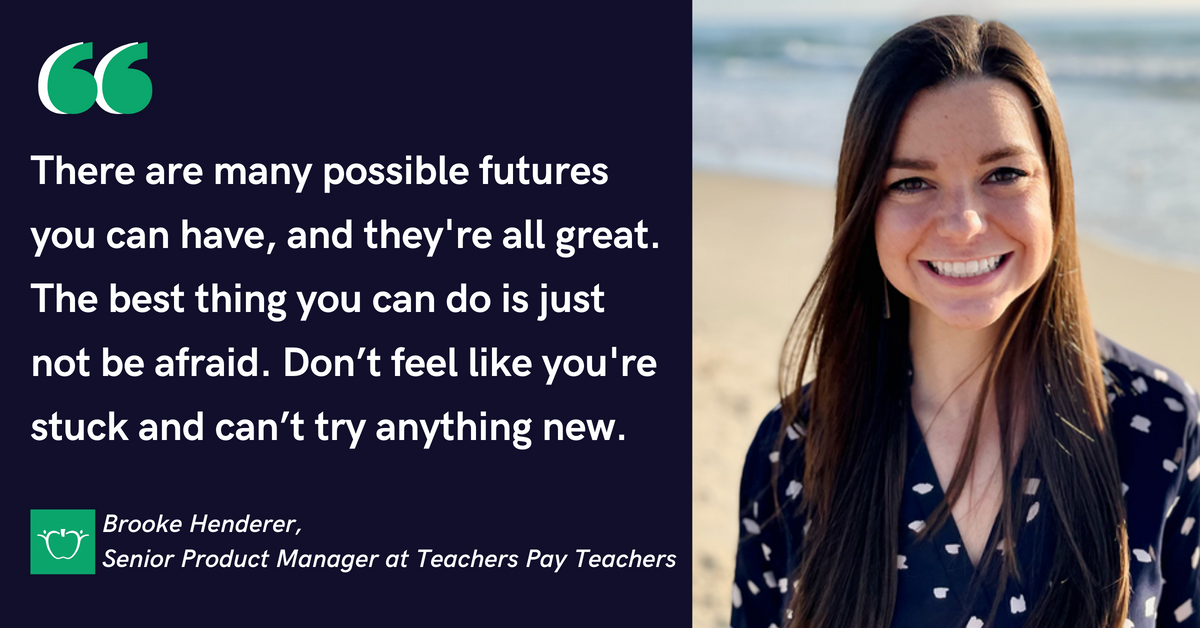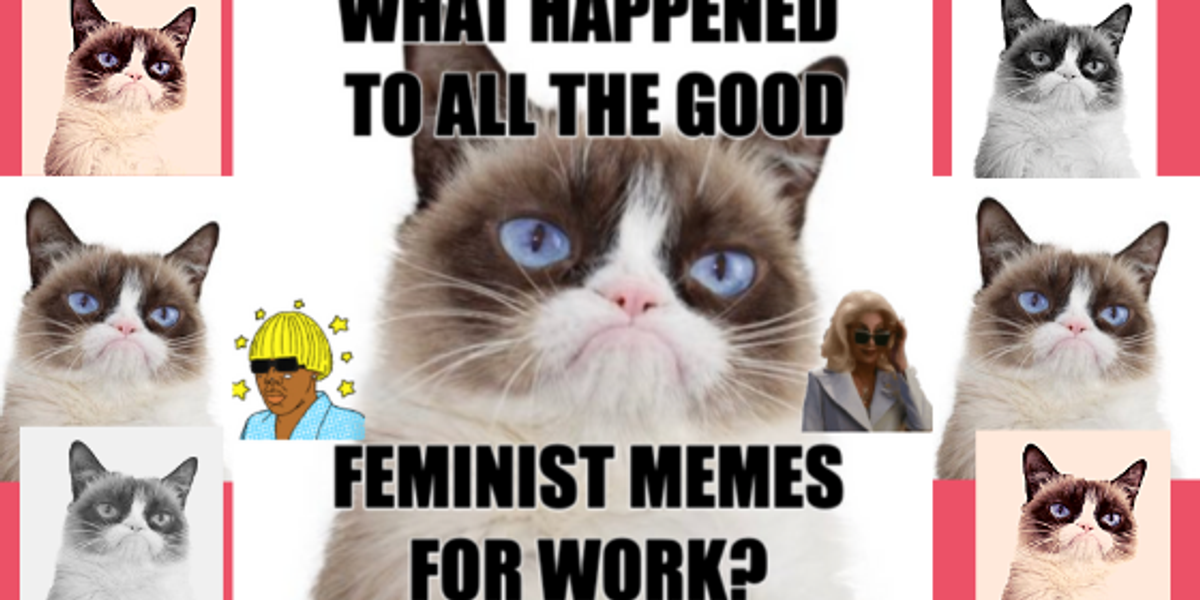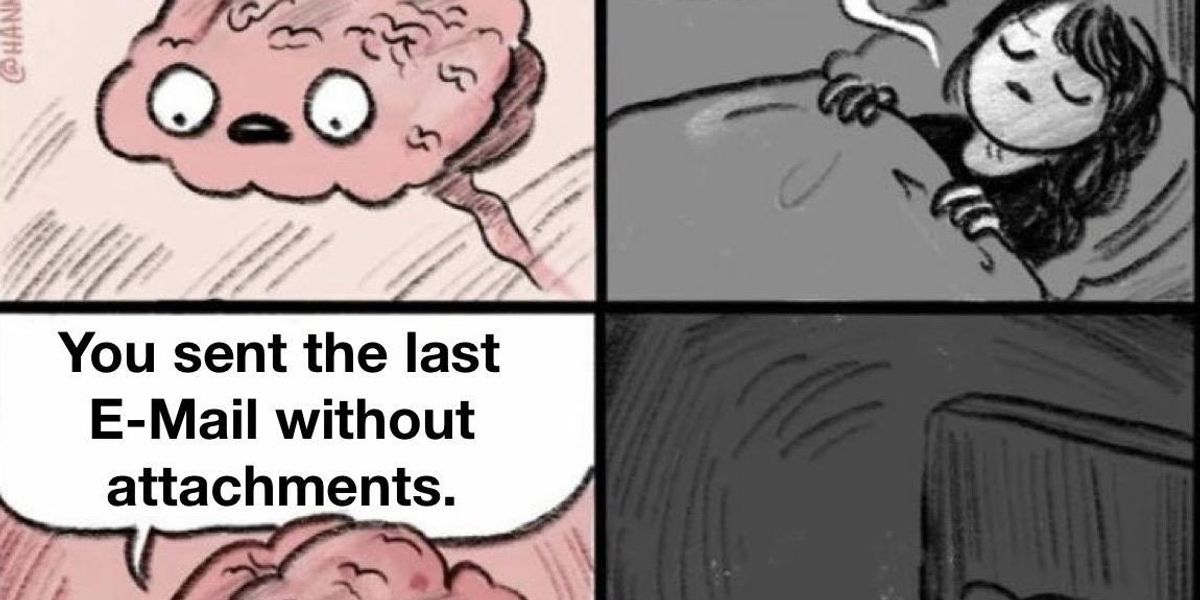Prototypes are to product managers what decks are to consultants.
They're a way to showcase one vision of the future—to give people an opportunity to experience it and to decide whether to pursue it.
As a senior product manager at education marketplace Teachers Pay Teachers, Brooke Henderer is quite familiar with the practice. She's made dozens of prototypes for different work projects over the years.
Recently, she's started to think about her own life as a series of prototypes, of different future options that she's explored and that have taught her what it is she really wants to pursue.
We sat down with Brooke to hear about how she got into product management, how she's applied her PM skillset to understanding what it is she wants to do with her life, and what advice she has for people who are looking to do some self-discovery and self-prototyping of their own.
A three-part framework
Brooke tried a lot of things in college. "I was definitely one of those people who did not know what they wanted to do," she says. "I had such broad interests that it was really hard for me to narrow them down."
She took classes that interested her, from chemistry to economics, and applied the same approach to her extracurricular activities, exploring everything from jobs in retail and customer service to internships in sales. "I really enjoyed getting to work with customers and helping people in some capacity," she says. She was particularly interested in tech—"It felt very future-proof," she notes—but realized that tech sales wasn't for her. "I didn't love the repetitive nature of being on the phone all day," she says. Becoming super-specialized wasn't appealing, either.
"I didn't want to be a craft developer because I don't know how to code. I'm not going to be a designer because I don't know how to design," she says. "I got really lucky stumbling upon product management, because it has the aspects of the customer-facing side of things I enjoy, and sales, but is also a mix of more creative and strategic work on different levels, and gets me exposure to a lot of different kinds of work throughout the day."
After getting her first PM job with Intuit from a career fair, Brooke stayed with that company for a while before looking for something new. When she set out to look for her next challenge, she had a clear framework in mind. Brooke was looking for:
- A mission she could connect to. "During my time at Intuit, I discovered that what ultimately motivates me and drives me is creating something for someone else and ideally creating a positive change for them. It was really important for me to know that whatever I was building or doing, it was something good for someone else," says Brooke.
- A smaller company. Brooke knew she wanted to work somewhere that wasn't so big that she wouldn't be able to be in the mix with different tasks each day. "There's something about doing something different every day and not having a lot of repetition that I really enjoy," she says. "And I'm comfortable with the rapid change and quick adaptation of smaller companies, because we're always building new products and we stay flexible to changes."
- A product roadmap that interested her. "I just knew that if it wasn't exciting on the surface, it probably wasn't gonna keep me there for long," says Brooke.
Teachers Pay Teachers met all of her criteria, and Brooke realized it was the place for her from her very first interview. "It really stuck out to me how clear the mission and strategy was, and how much love every single employee and leader had for educators," she says. "It was genuine."
She felt particularly drawn to TPT's mission. "Our strategy has to do with unlocking funds for educators so they don't have to reach into their own pockets to get the resources and tools they need. It's a really unique opportunity to work somewhere where the business goals align with doing something really good for customers," says Brooke.
Stepping back from a job to consider a life
After Brooke got her first product management role, she expected her questions about her career to abate. They didn't.
"Getting that first job was this big thing. Then you realize, 'Oh, this can grow, this can change, this doesn't have to be the single thing I do for the rest of my life.' So how do I make sure I'm still in a career I like, and that I'm figuring out how to hone in on my interests over time?" she reflects.
She started applying her product manager skill set to her own life.
A book called Designing Your Life helped, she says, by teaching her how to ask herself what she wanted out of life beyond her job. It led to her realizing that she really enjoyed building tangible things, so she decided to explore content creation.
After taking a film class and producing a short documentary, Brooke realized she wanted to stay in product, and credits her exploration with her renewed sense of commitment to and peace with her career decision.
"Going through that process, taking the film class, doing those things really proved to myself, 'Oh, there's actually not a whole lot of other things that really fit what I want,'" says Brooke.
"Because I was able to prototype those things and try them out, it helped me feel better about doubling down on staying in product. It made me feel more secure in the path I was choosing," says Brooke. "I learned other things I might like, but that might be better as hobbies for me."
6 tips for self-discovery at work and beyond
If you've wondered if you should blow up your life and start all over—and if you should, how exactly you're to begin that process—Brooke has some perspective for you. Spoiler alert: it's a gradual approach.
- First, recognize that there's no single right path for you. "There are many possible futures you can have, and they're all great," says Brooke. "The best thing you can do is just not to be afraid. Don't feel like you're stuck and can't try anything new."
- Try a "good time" journal. Keep an activity log of all of the things you do in a given day and note how much energy you get from them. "You could do it for a week or for a day," says Brooke. "I think you'll be surprised at what you learn about what fills you up. What type of things were you doing? What types of people were there? What role were you in? What sorts of things were there—computers, sticky notes, whiteboards?"
- Be more conscious of your schedule. Once you know what kinds of things drain you, Brooke suggests adjusting your schedule to better absorb them. For example, if she has a long day of draining meetings, she'll schedule some time to talk to a customer right afterwards, since those chats always give her energy. "Not everything in work is going to be perfect," says Brooke. "But as much as you can fill your bucket up with those things that give you energy, you can use that as a guide to help you figure out where you want to go."
- Carve out enough time for deep work. Even if meetings do bring you energy, too many of them will make you feel like you're unable to make progress on any longer-term goals or even to think about what your personal goals are. Make sure you're getting at least a few hours a week for heads-down work, notes Brooke.
- Set boundaries, including around breaks. To avoid the constant interruptions of Slack messages and emails, Brooke responds to them at certain times of day. She also has scheduled small breaks that she sticks to. "It's about actually standing up and stepping away from your computer," she says.
- Ask if you can shift enough within where you are to meet your needs, or if a bigger shift is needed. Sometimes it's enough to adjust smaller parts of your life, whether that's what your schedule looks like or even the company you work for, in order to feel more aligned with the things and activities that bring you energy. But sometimes it's not. "Long term, you need to think about changes you want to make," says Brooke. In that case, the same advice applies, just starting with a bigger scale. "Everything might not be clear just yet, but you'll figure it out as you go."
Learn more about Teachers Pay Teachers and their open roles.




